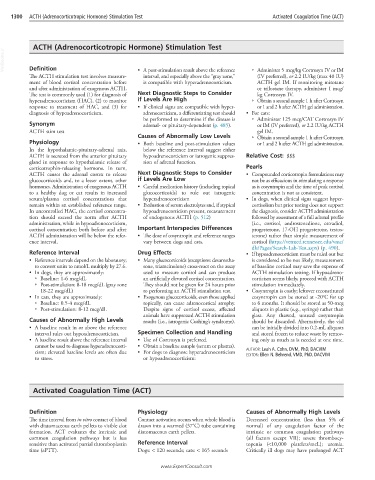Page 2575 - Cote clinical veterinary advisor dogs and cats 4th
P. 2575
1300 ACTH (Adrenocorticotropic Hormone) Stimulation Test Activated Coagulation Time (ACT)
ACTH (Adrenocorticotropic Hormone) Stimulation Test
VetBooks.ir Definition
(IV preferred), or 2.2 IU/kg (max 40 IU)
interval, and especially above the “gray zone,”
The ACTH stimulation test involves measure- • A post-stimulation result above the reference ○ Administer 5 mcg/kg Cortrosyn IV or IM
ment of blood cortisol concentration before is compatible with hyperadrenocorticism. ACTH gel IM. If monitoring mitotane
and after administration of exogenous ACTH. or trilostane therapy, administer 1 mcg/
The test is commonly used (1) for diagnosis of Next Diagnostic Steps to Consider kg Cortrosyn IV.
hyperadrenocorticism (HAC), (2) to monitor if Levels Are High ○ Obtain a second sample 1 h after Cortrosyn
response to treatment of HAC, and (3) for • If clinical signs are compatible with hyper- or 1 and 2 h after ACTH gel administration.
diagnosis of hypoadrenocorticism. adrenocorticism, a differentiating test should • For cats:
be performed to determine if the disease is ○ Administer 125 mcg/CAT Cortrosyn IV
Synonym adrenal- or pituitary-dependent (p. 485). or IM (IV preferred), or 2.2 IU/kg ACTH
ACTH stim test gel IM.
Causes of Abnormally Low Levels ○ Obtain a second sample 1 h after Cortrosyn
Physiology • Both baseline and post-stimulation values or 1 and 2 h after ACTH gel administration.
In the hypothalamic-pituitary-adrenal axis, below the reference interval suggest either
ACTH is secreted from the anterior pituitary hypoadrenocorticism or iatrogenic suppres- Relative Cost: $$$
gland in response to hypothalamic release of sion of adrenal function.
corticotrophin-releasing hormone. In turn, Pearls
ACTH causes the adrenal cortex to release Next Diagnostic Steps to Consider • Compounded corticotropin formulations may
glucocorticoids and, to a lesser extent, other if Levels Are Low not be as efficacious in stimulating a response
hormones. Administration of exogenous ACTH • Careful medication history (including topical as is cosyntropin and the time of peak cortisol
to a healthy dog or cat results in increased glucocorticoids) to rule out iatrogenic concentration is not as consistent.
serum/plasma cortisol concentrations that hyperadrenocorticism • In dogs, when clinical signs suggest hyper-
remain within an established reference range. • Evaluation of serum electrolytes and, if atypical cortisolism but prior testing does not support
In uncontrolled HAC, the cortisol concentra- hypoadrenocorticism present, measurement the diagnosis, consider ACTH administration
tion should exceed the norm after ACTH of endogenous ACTH (p. 512) followed by assessment of a full adrenal profile
administration, while in hypoadrenocorticism, (i.e., cortisol, androstenedione, estradiol,
cortisol concentration both before and after Important Interspecies Differences progesterone, 17-OH progesterone, testos-
ACTH administration will be below the refer- • The dose of cosyntropin and reference ranges terone) rather than simple measurement of
ence interval. vary between dogs and cats. cortisol (https://vetmed.tennessee.edu/vmc/
dls/Pages/Search-Lab-Test.aspx) (p. 490).
Reference Interval Drug Effects • If hypoadrenocorticism must be ruled out but
• Reference intervals depend on the laboratory; • Many glucocorticoids (exceptions: dexametha- is considered to be not likely, measurement
to convert units to nmol/L multiply by 27.6. sone, triamcinolone) cross-react on the assay of baseline cortisol may save the expense of
• In dogs, they are approximately: used to measure cortisol and can produce ACTH stimulation testing. If hypoadreno-
○ Baseline: 1-6 mcg/dL an artificially elevated cortisol concentration. corticism seems likely, proceed with ACTH
○ Post-stimulation: 8-18 mcg/dL (gray zone They should not be given for 24 hours prior stimulation immediately.
18-22 mcg/dL) to performing an ACTH stimulation test. • Cosyntropin is costly; leftover reconstituted
o
• In cats, they are approximately: • Exogenous glucocorticoids, even those applied cosyntropin can be stored at -20 C for up
○ Baseline: 0.5-4 mcg/dL topically, can cause adrenocortical atrophy. to 6 months. It should be stored as 50-mcg
○ Post-stimulation: 8-12 mcg/dL Despite signs of cortisol excess, affected aliquots in plastic (e.g., syringe) rather than
animals have suppressed ACTH stimulation glass. Any thawed, unused cosyntropin
Causes of Abnormally High Levels results (i.e., iatrogenic Cushing’s syndrome). should be discarded. Alternatively, the vial
• A baseline result in or above the reference can be initially divided into 0.2-mL aliquots
interval rules out hypoadrenocorticism. Specimen Collection and Handling and stored frozen to reduce waste by remov-
• A baseline result above the reference interval • Use of Cortrosyn is preferred. ing only as much as is needed at one time.
cannot be used to diagnose hyperadrenocorti- • Obtain a baseline sample (serum or plasma).
cism; elevated baseline levels are often due • For dogs to diagnose hyperadrenocorticism AUTHOR: Leah A. Cohn, DVM, PhD, DACVIM
EDITOR: Ellen N. Behrend, VMD, PhD, DACVIM
to stress. or hypoadrenocorticism:
Activated Coagulation Time (ACT)
Definition Physiology Causes of Abnormally High Levels
The time interval from in vitro contact of blood Contact activation occurs when whole blood is Decreased concentration (less than 5% of
with diatomaceous earth pellets to visible clot drawn into a warmed (37°C) tube containing normal) of any coagulation factor of the
formation. ACT evaluates the intrinsic and diatomaceous earth pellets. intrinsic or common coagulation pathways
common coagulation pathways but is less (all factors except VII); severe thrombocy-
sensitive than activated partial thromboplastin Reference Interval topenia (<10,000 platelets/mcL); uremia.
time (aPTT). Dogs: < 120 seconds; cats: < 165 seconds Critically ill dogs may have prolonged ACT
www.ExpertConsult.com

